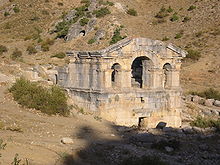Comana (Cappadocia)
 Comana | |
| Location | Şar, Adana Province, Turkey |
|---|---|
| Region | Cappadocia |
| Coordinates | 38°19′48″N 36°19′48″E / 38.33000°N 36.33000°E |
| Type | Settlement |
| Site notes | |
| Condition | In ruins |
Comana was a city of
Comana in Pontus). The Hittite toponym Kummanni is considered likely to refer to Comana, but the identification is not considered proven.[2] Its ruins are at the modern Turkish village of Şarköy, Tufanbeyli district, Adana Province.[3]
History
According to ancient geographers, Comana was situated in Cappadocia (and later CataoniaMelitene, near the Euphrates.
National Museum in Warsaw
.There was a tradition that
Tauric Scythia the sacred rites of this temple, which were those of Tauropolos Artemis
. Here Orestes deposited the hair that he cut from his head to commemorate the end of his sufferings (ἡ πένθιμος κόμη), and hence, according to a folk etymology of the Greeks, came the name of the place, Comana. And in later times, to make the name suit the story better, as it was supposed, it was changed to ἡ Κόμανα. (Eustath. ad Dionys. v. 694; Procop. Persic. i. 17.)
The city minted coins in antiquity that bear the epigraphs Col. Aug. Comana, and Col. Iul. Aug. Comanenoru or Comainoru.
The site lies at Şarköy or Şar (once usually transcribed Shahr), a village in the
Melitene (modern Malatya), converted by Septimius Severus into the chief military road to the eastern frontier of the empire. The extant remains at Şar include a theatre on the left bank of the river, a fine Roman doorway and many inscriptions; but the exact site of the great temple has not been satisfactorily identified. There are many traces of Severus's road, including a bridge at Kemer, and an immense number of milestones, some in their original positions, others reused in cemeteries.[6]
Ecclesiastical history
It remains a Roman Catholic
Fifth Ecumenical Council
, in 553.
The ruins of Comana are visible ten miles north-west of
Lequien, I, 447; William Mitchell Ramsay
, The Historical Geography of Asia Minor).
Homonymous dioceses
- Another episcopal see named vilayet of Sivas.
- Lequien (I, 1009) gives another Comana in vilayet of Adana.
See also
- Saint John the Baptist, whose head was found at Comana in the 9th century, according to Church tradition
Sources and references
- ^ Eustathius, Commentary on Dionysius, 694) surnames it Chryse, "Golden".
- ^ Sirkeli Archaeological Project Archived 2009-01-05 at the Wayback Machine
- ISBN 0-691-03169-X), Map 64 & notes.
- ^ Strabo, XI, 521
- ^ Strabo, XI, 521; XII, 535, 537.
- ^ a b Hogarth 1911.
- This article incorporates text from a publication now in the public domain: Hogarth, David George (1911). "Comana". In Chisholm, Hugh (ed.). Encyclopædia Britannica. Vol. 6 (11th ed.). Cambridge University Press. p. 749.
 This article incorporates text from a publication now in the public domain: Herbermann, Charles, ed. (1908). "Comana". Catholic Encyclopedia. Vol. 4. New York: Robert Appleton Company.
This article incorporates text from a publication now in the public domain: Herbermann, Charles, ed. (1908). "Comana". Catholic Encyclopedia. Vol. 4. New York: Robert Appleton Company. This article incorporates text from a publication now in the public domain: Smith, William, ed. (1854–1857). "Comana". Dictionary of Greek and Roman Geography. London: John Murray.
This article incorporates text from a publication now in the public domain: Smith, William, ed. (1854–1857). "Comana". Dictionary of Greek and Roman Geography. London: John Murray.

